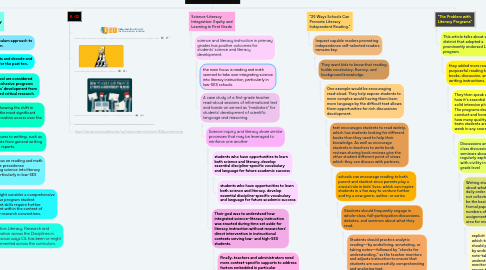
1. This Is Wow: A Case for Critical Information Literacy across the Curriculum.
1.1. writing across the curriculum approach to critical library instruction.
1.2. Maria work with students and decode and using research sources for the past ten.
1.2.1. college and high school are considered comprehensive and cohesive programs that support students' development from beginning to advanced critical research.
1.2.1.1. Maria began by showing the shift in friction between the most significant changes and information access over the past ten years.
1.2.1.1.1. multiple exposures to writing, such as moving students from general writing skills to higher reports.
1.2.1.1.2. frequent, a focus on reading and math seemed to take precedence over integrating science into literacy instruction, particularly in low-SES schools.
2. "The Problem with Literacy Programs"
2.1. This article talks about a school district that adopted a prominently endorsed Literacy program.
2.1.1. they added more reading, purposeful reading high-quality books, discussion, and explicit writing instructions.
2.1.1.1. They then speak of reading and how it's essential to start with a solid intensive phonics regimen. The programs developers should conduct and honest auditees of how many quality books and texts students are reading each week in any course.
2.1.1.1.1. Discussions and how the whole class discussions debates and seminars about starting to do it regularly explicit in speaking with civility in every subject and grade level
3. Science-Literacy Integration: Equity and Learning in First Grade
3.1. science and literacy instruction in primary grades has positive outcomes for students’ science and literacy development.
3.1.1. the main focus is reading and math seemed to take over integrating science into literacy instruction, particularly in low-SES schools.
3.1.2. A case study of a first-grade teacher read-aloud sessions of informational text and hands-on served as “mediators” for students’ development of scientific language and reasoning.
3.1.2.1. Science inquiry and literacy share similar processes that may be leveraged to reinforce one another
3.1.2.1.1. students who have opportunities to learn both science and literacy, develop essential discipline-specific vocabulary and language for future academic success
3.1.2.1.2. Their goal was to understand how integrated science–literacy instruction was enacted during time set aside for literacy instruction without researchers’ direct intervention in instructional contexts serving low- and high-SES students.
4. "25 Ways Schools Can Promote Literacy Independent Reading."
4.1. Inquest capable readers promoting independence self-selected readers remains key.
4.1.1. They want kids to know that reading builds vocabulary, fluency, and background knowledge.
4.1.1.1. One example would be encouraging read-aloud. They help expose students to more complex would having them learn more language by the difficult text allows them opportunities for rich discussions development.
4.1.1.1.1. text encourages students to read widely, which has students looking for different books than they used to help their knowledge. As well as encourage students in teachers to write book reviews sharing book reviews give the other student different point of views which they can discuss with partners.
